Learn how your business can succeed with a customer data platform.
Implementing a new Customer Data Platform (CDP) at your company is a big process. Choosing the right vendor is only part of the process – you’ve also got to make sure your company is prepared to make the most of a powerful new tool.
Customer Data Platforms are the hot topic of the marketing world, and rightfully so. The promise of being able to break down data silos and build a complete picture of your customer with a marketer-friendly tool is hard to resist.
You might even think that a CDP is a silver bullet, and all you’ve got to do is choose the right vendor. But the truth is, picking the right vendor is only part of the equation. Having the right mindset, laying the proper groundwork, and establishing the right processes are also equally important.
At Exponea, we have lots of experience helping companies across multiple industries make the most of their CDP projects. We’ve collected some of our most valuable information here – use it to ensure that your CDP delivers what you expect.
The holy grail of CDP implementation
After hundreds of CDP implementations, we’ve discovered three key factors that are present in every successful project. Together, they make up what we call the Holy Grail of CDP Implementation. You can find those elements below:
- A holistic customer-centric approach
- Use cases that activate your customer data
- A team with the right skillset
Let’s dig a little deeper into each of those elements.
A holistic customer-centric approach
This first element is possibly the most challenging one to get right. It’s not the kind of thing you can achieve overnight. Depending on your existing company structure and culture, changing to a truly customer-centric organization might mean significant cultural change.
So don’t worry about getting this right from the very beginning. But be aware that to make the most of a CDP, you need a customer-centric organization. Think about small steps you can take to move in that direction, and take them.
We’ve identified some of the key steps in the process of becoming customer-centric. We’ve outlined them below, along with why you should even care about being customer-centric in the first place.
Why become customer-centric?
CDPs are, by nature, customer centric. Company structures very often are not. Consider marketing departments: in many organizations, teams are built around channels. One team for email, another for social, a team for direct mail campaigns, and so on.
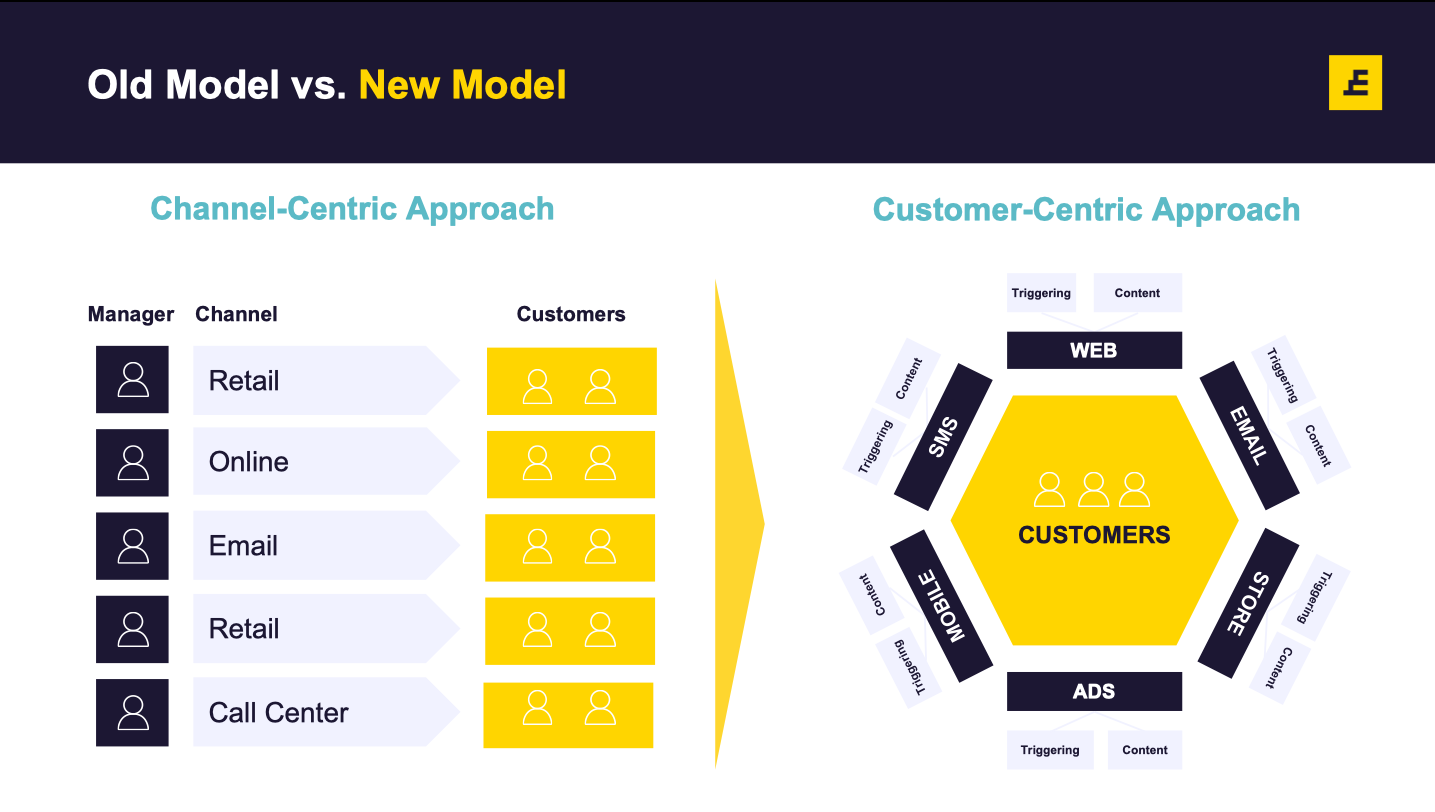
Source: Exponea
This creates data silos and a fragmented picture of your customer. One team doesn’t know what the other one is up to, and the customer ends up with a disjointed experience.
If you want to avoid this, you need to become customer-centric. A CDP makes this transition much easier by breaking down silos and giving everyone access to a complete picture of your customer.
If you can put customer-centricity into the DNA of your company, you will be better equipped to take advantage of all the capabilities a CDP can provide. Although this change takes time, it’s a project worth undertaking.
Drive decisions with customer-centric insights
It’s not enough to become customer-centric in name only. You have to become customer-centric in your decision making.
CDPs have powerful analytics capabilities, and can tell you a lot about your customers. But for a CDP to provide value, you need to use those insights to make decisions. Insight without action isn’t worth much. That’s why the next factor is so critical.
The right KPIs at the highest levels
Someone in your C-suite needs to have a KPI that’s focused on customer loyalty. Why?
Because customer-centricity and customer loyalty go hand-in-hand, and customer loyalty is measurable. And if you want to become customer centric, you need someone at the top of your organization with skin in the game.
Examples of KPIs
Average Customer Lifetime Value (CLV or CLTV).
One way to calculate this:
CLV = Average Order Value * Purchase Frequency * Gross Margin * (1/Churn)
By including both churn and purchase frequency, following this metric over time serves as a good weather vane of customer loyalty.
Customer Equity
Closely related to the last metric:
Customer Equity = CLV * Number of customers acquired in given period
This gives you a top-level overview of the value of your customer base, and gives an at-a-glance measure about the quality of your customer base.
Customer Lifecycle Distribution
A snapshot of how loyal your customer base is. Watch this metric closely; and big swings in the distribution of customers among lifecycle segments can point to changes in the loyalty of your customer base.
Cross-departmental buy-in
CDPs might seem marketing-focused. But they can bring a lot of value to other departments as well. As you make a change to a customer-centric organization, you want to make sure that members from several teams across multiple departments understand the customer and have access to full customer profiles.
This will further help engrain customer-centricity into your whole company, increasing the value you can get out of your CDP.
Marketing department & CDP
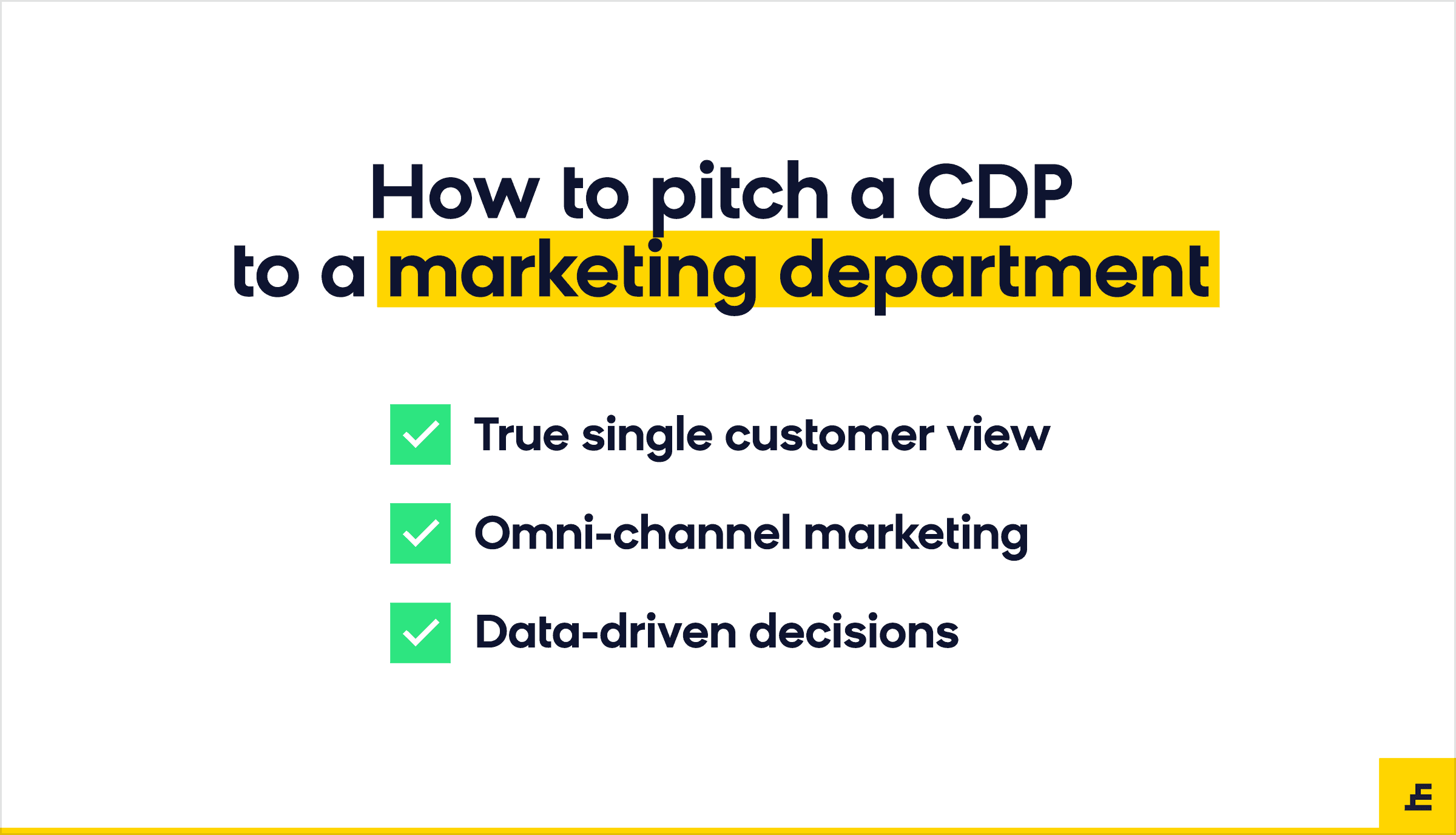
Marketing shouldn’t require much convincing. In fact, it is probably the department that’s pushing for a CDP in the first place. But if not, it shouldn’t be difficult to persuade marketers that a CDP will make their jobs easier. Some key points:
- True single customer view. Unified, holistic customer profiles mean a significantly better understanding of the customer base.
- Omni-channel marketing. Many CDPs have native omni-channel execution capabilities, and those that don’t are usually able to integrate with the marketing platforms you already use.
- Data-driven decisions. The powerful segmentation and analytics abilities of a CDP can replace gut feelings with insights informed by data, making it easier to support new initiatives.
IT department & CDP
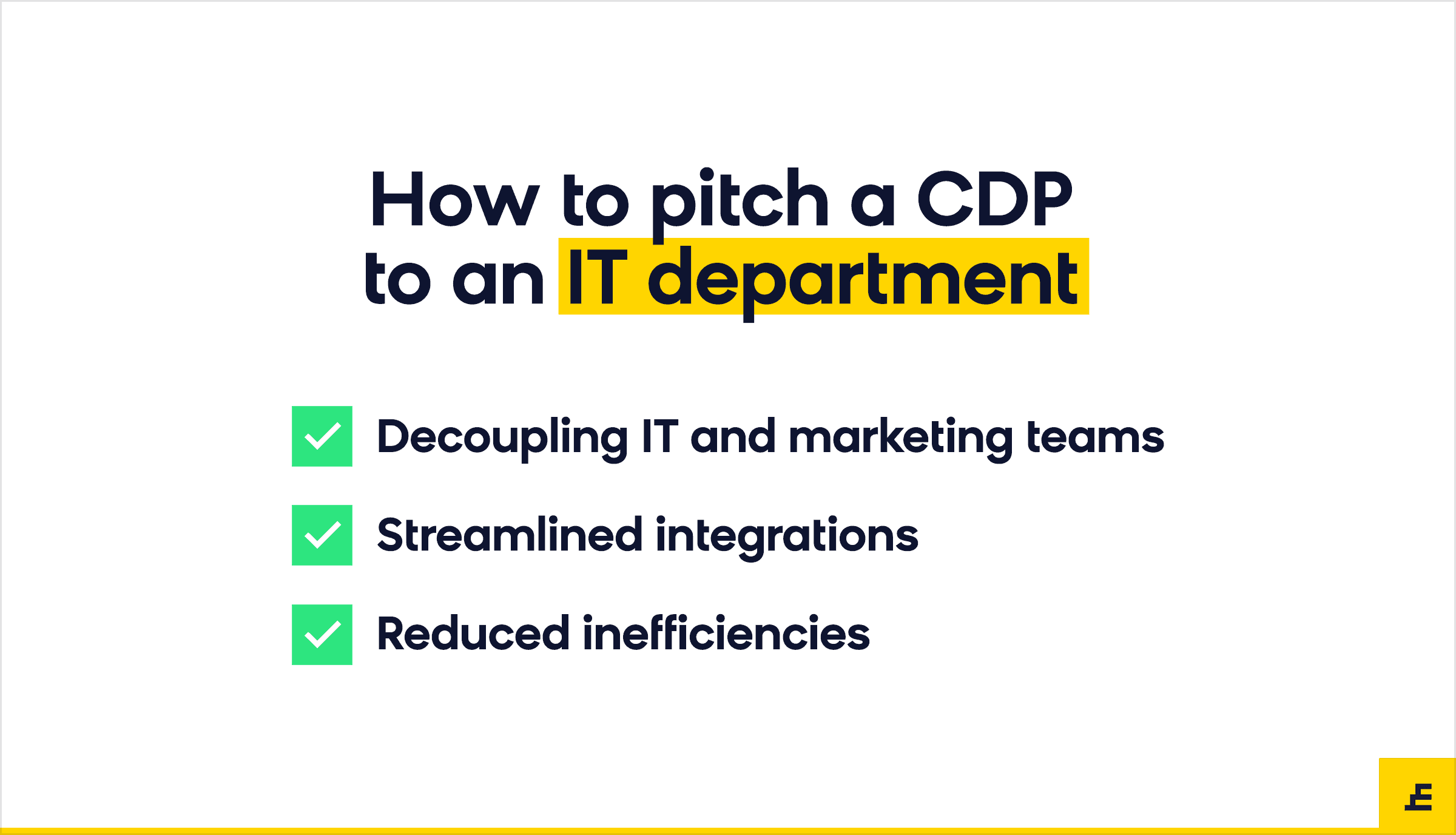
IT employees might be some of the biggest fans of a CDP. When properly adopted, a CDP should significantly decrease demands on their time from marketing.
- Decoupling IT and marketing teams. A CDP enables marketers to query customer data without having to rely on IT resources, making both teams more productive.
- Streamlined integrations. Most CDPs offer pre-built integrations with marketers’ most commonly used tools, so IT teams won’t have to spend time setting up complicated integrations.
- Reduced inefficiencies. CDPs create one central location to deal with customer audiences and business rules, removing the need to duplicate these efforts across multiple platforms.
Sales department & CDP
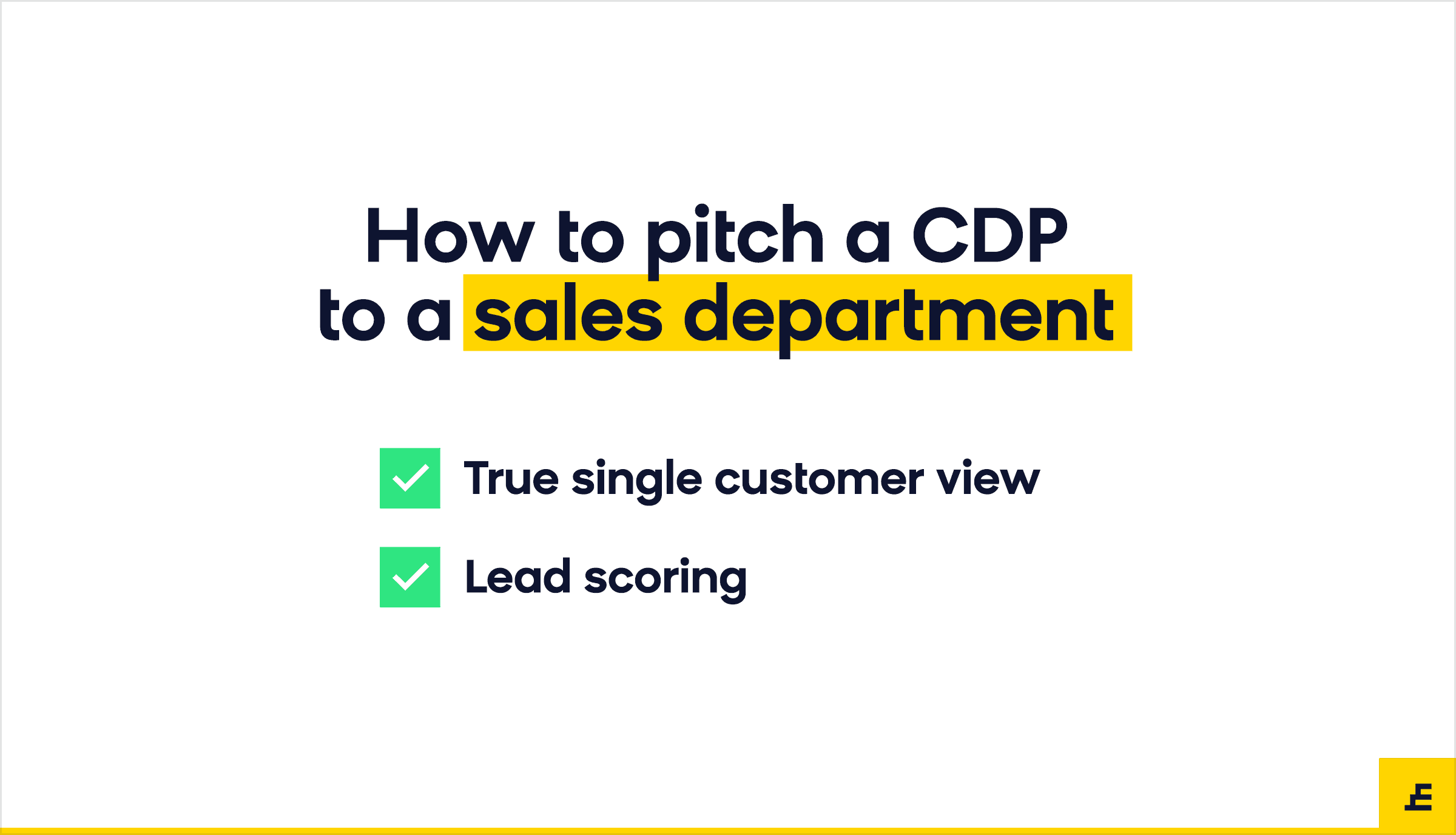
Typically, sales departments won’t see too many direct benefits from a CDP, since the platform is usually managed by marketing teams. But improved marketing efforts should (indirectly) benefit sales. There are even some B2B-focused CDPs that will be used directly by sales teams, and most CDPs should be able to do the following:
- Lead scoring. After ingesting data from all sources and compiling it into a single profile of a customer, a CDP can then rank all those actions to determine how “hot” a lead is, and reach out accordingly. Sales teams can be automatically notified of hot leads via an integration with an internal messaging tool.
- True single customer view. Having all the information about a prospect in one profile can add a lot of valuable context to a sales conversation.
Customer service department & CDP
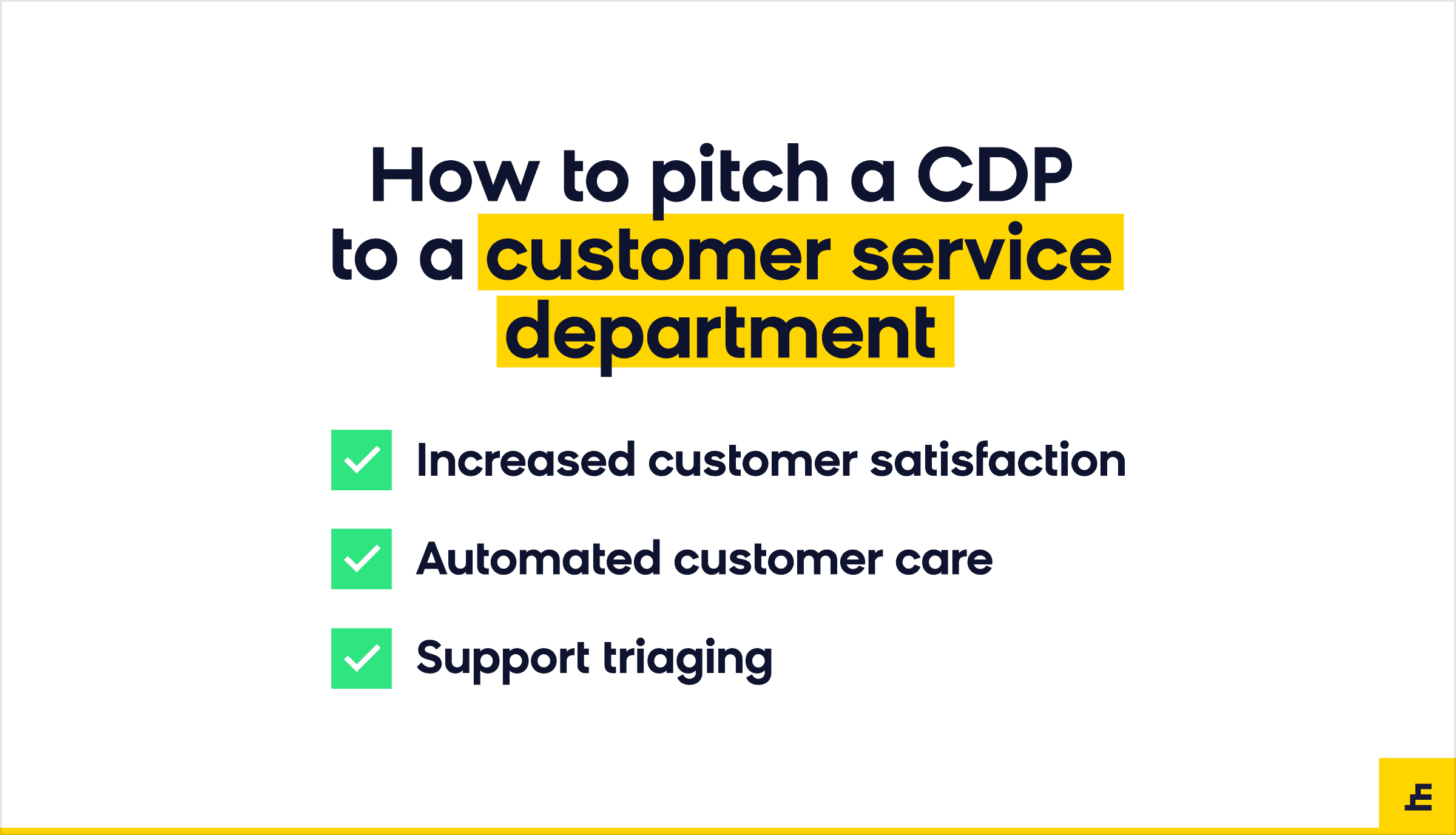
CDPs can offer a lot of the same functionality as a CRM, and can even enrich CRM systems with the data they collect.
- Increased customer satisfaction. The complete customer profile provided by a CDP can provide crucial context to customer conversations, leading to much better customer experiences.
- Automated customer care. CDPs with built-in communication automation can send NPS surveys or other communications to customers who have recently interacted with your brand, and customers who recently purchased can get automatic requests for a review.
- Support triaging. CDPs can perform triage on customers in need of support, and ensure that those customers with the most urgent needs are managed as soon as possible.
Business intelligence department & CDP
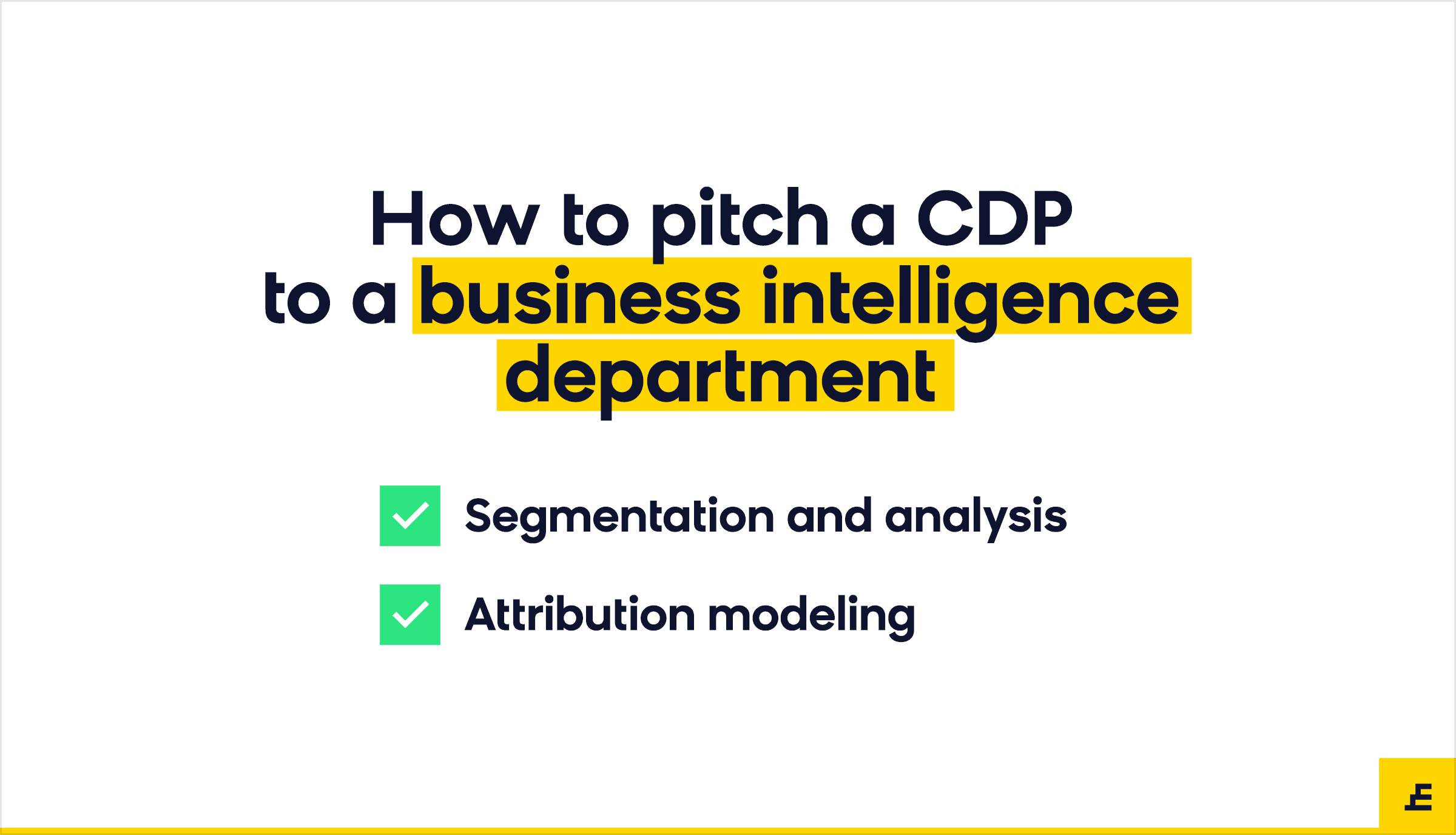
CDPs are very interesting for business intelligence departments, thanks to their ability to ingest and analyze multiple sources of customer data.
- Segmentation and analysis. CDPs can provide a huge wealth of insights about the customer journey and buyer behavior.
- Attribution modeling. Some CDPs offer this capability, which can help determine ROI from marketing efforts.
If you can get buy-in across these departments, you’ll either have a customer-centric organization, or be well on your way towards one. The next factor you’ll want to address is data activation.
Use cases for data activation
A holistic approach to customer-centricity across your entire organization is key to a successful CDP project. But it’s important not to stop there. Customer-centricity is certainly a good goal, but it’s probably not the sole reason you got a CDP. You need to take advantage of the full scale of customer data you have, and put it to work with use cases that activate that data.
Value-building use cases
Carefully consider how you want to improve the customer experience, and map this against the capabilities of your new CDP and your existing tools. Take into account the full scale of customer data available to you, and design ways to use that to bring value to your customers.
It’s fine to start small here. Simple use cases like segmenting your email database, sending emails at the right time, or discontinuing vouchers for customers that aren’t price-sensitive, are a good place to start. You can establish them quickly and start proving value to other members of your organization.
Your CDP vendor should be helpful here. They’ll have experience in creating and delivering valuable use cases. Work with them to discover how you can make the most of your CDP.
Here are some of the high-value use cases our clients have implemented. They take advantage of the capabilities of a CDP to deliver value to both the client and their customers.

1. Online + Offline Connection
Merging online and offline activities can create a more complete, holistic customer profile. CDPs can Identify customers from online activities when they enter a brick and mortar store and vice-versa, creating a seamless buyer experience and generating value for the customer.
Related Success Story: Sofology & Exponea: How to get the most out of Exponea
2. Customer Segmentation & Personalization
Segmenting customers according to their behavior (on your site or in your store) enables you to deliver a personalized, omni‑channel experience throughout the entire customer lifecycle.
Related Use Case: How to build personalized micro-segments
3. Product Recommendations
The rich data collected by a CDP can be used in conjunction with product recommendation engines (sometimes included in a CDP’s offering). These recommendations can drive engagement, increase brand loyalty, and sell, up‑sell, or cross‑sell your products or services.
Related Use Case: How to automate newsletters to save time & increase conversions
4. Conversion Rate Optimization & A/B Testing
Combining full customer profiles with web optimization allows you to deliver tailored experiences to every customer segment. Today’s customers expect personalized experiences, and CDPs can make it possible.
Related Success Story: Connox uses Exponea to make a big impact
5. Predictive Customer Scoring
Some CDPs can make AI-powered predictions based on the data they collect. These predictions can enrich your customer profiles with their data (probability of purchase, churn, visit, email open), which can then be used to make more effective business decisions.
Related Use Cases: The Latest Predictive Marketing Techniques to Boost Your E-Commerce!
6. Smart Behavioral Retargeting
Behavioral data from a CDP can be used to create retargeting audiences on the major advertising platforms. These audiences tend to perform very well, thanks to the granularity of data from a CDP.
Related Use Case: How to use predictive audiences to target better for increased ROAS and higher ROIng strategy
7. Omni-Channel Automation
Combining a CDP with marketing automation allows you to guide your customers through their entire lifecycle with personalized and timely messages sent to their preferred channel, significantly enhancing your opportunities to both acquire and keep loyal customers.
Related Use Case: How to boost loyalty and target customers on the right channel using omni-channel personalization
8. Email Deliverability Enhancement
A CDP allows you to use behavioral data to determine the ideal email sending time for each user, based on their email opening habits.
Related Use Case: Frequency management: How to set up dynamic email send policies
Failing to implement use cases early on can be detrimental. You might spend months trying to move towards a more customer-centric organization, with no use cases to show why that could be valuable. On the other hand, if you can prove value early on, it’s much easier to get buy-in across the organization.
Of course, to execute these use cases, you need to have the right people. Which brings us to the last element of our holy grail: team members.
Team members with the right skills
Once you have a plan for the type of use cases you want to execute, you will also be able to determine the skills you’ll require to accomplish them. Take inventory of your team, and find the overlap between the skills you need and the skills you have. Then determine if you want to hire new team members or train the people you already have.
You need to have a team that can take advantage of the capabilities of your CDP, so make sure to have a clear understanding of what you need and what you have.
With the right team, the right use cases, and a customer-centric approach, you can achieve great results with your CDP.
The Holy Grail to CDP Success (Video Summary)
In order to discover what are the key ingredients for a successful CDP project, we interviewed a number of experts at Exponea. We’ve shared one of those interviews here. Watch it to discover the framework that Peter Jakus, VP of Industry & Market Insights (former Head of Exponea Academy), has created to help companies make the most of their CDP.
Closing Thoughts
With all the hype around CDPs, it can be easy to get carried away. It’s important to set realistic expectations before embarking on a CDP project. But at the same time, you shouldn’t think that CDPs are totally overblown. The truth is somewhere in between: they can be an extremely powerful tool for your business, but it will take a bit of work from both the vendor and the client.
Success with a CDP project is a process, but by laying the right foundation, and starting with the right ingredients, you can make a valuable endeavor much more likely. While every company has different needs, adhering to the general principles of our framework will help make your CDP project a success.
Companies like Missguided, Desigual, T-Mobile, Sofology, and more use Exponea to make the most of their data and foster win-win relationships with their customers. Check out the capabilities of Exponea in this 3-minute video, and see how it enables customer-centric growth.
WHAT SHOULD YOU READ NEXT? AUTHOR'S HAND-PICKED RECOMMENDATION:
CDP vs DMP vs CRM: Which one is best for your business?
In this one‑page comparison guide, you'll get the pocket‑sized know-how to summarize, differentiate, help identify the data platform that's right for you.




 Blog
Blog







